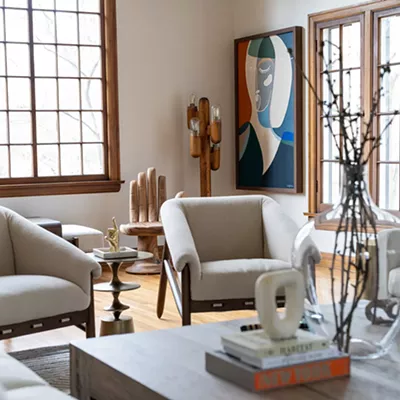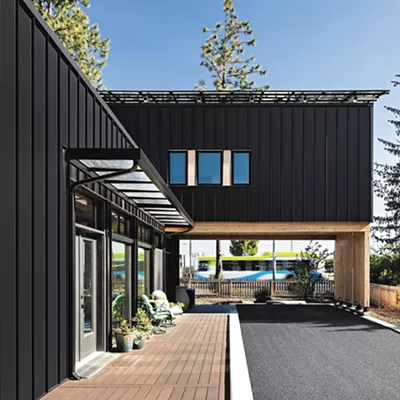Old Hat Workshop founder Jon Tettleton has a holistic approach to woodworking, from design to sourcing materials and finish work. Incorporating live or natural edges, for example, factors the tree's contour into the both the aesthetic and construction of the piece. And if the tree were cut in winter, the bark will be sturdy enough to be incorporated into the design, explains Tettleton, who has done live edge pieces for both residential and commercial clients, including Spokane's Seven2 design agency.
Client meetings include pricing and scope, and then Tettleton finalizes the design and sources materials. He's partial to walnut, he says, from his 40-foot-by-40-foot shop on North Monroe, and he often works with fir. "We will use veneer, which can be more sustainable," he adds, although he values solid wood's livability and durability.
When it comes to finishing the wood, he prefers oil, which is transparent, to stains, says Tettleton, because stains can alter the wood's appearance, obscuring the grain. If the wood's natural color isn't appealing, "Why not go with a different wood?" he asks, picking up small samples lying on his workbench. There's teak, Brazilian cherry and ipe, sometimes called Brazilian walnut, all of which he'd like to work with more.
Tettleton's frequent collaborators include Emily Mejia at Emily Anne Interior Design, local welders and an arborist who occasionally brings him salvaged wood.
"I think a lot of people are combining hard stuff — concrete and metal — with wood," says Tettleton, who likes the balance and warmth wood can bring to an otherwise industrial setting. The tables he created for the Casper Fry restaurant in Spokane, for example, combine steel edging and gear-laden metal bases with thick slabs of wood; every nick and dent became part of the table's narrative.
Tettleton's own narrative starts in Texas, where an inspirational shop teacher worked alongside his students to create a viable musical instrument. In 2011, he moved to Spokane to help establish a church. Tettleton appreciated the challenge and joy of making something functional, yet it wasn't until he apprenticed with a Spokane neighbor doing high-end woodworking that he felt himself drawn back to the vocation.
Small projects turned into larger ones, with clients including numerous Spokane businesses — Madeleine's Café Patisserie, Durkin's Liquor Bar, Lantern Tap House, Wellness Tree Health Clinic & Juice Bar and Indaba Coffee in Kendall Yards. All of them contributed to Tettleton's reputation for thoughtful use of materials.
What others might regard as flaws in wood — knots, splits and holes —Tettleton views as essential. "Impurities are part of our story," he writes on his webpage, "so let us not remove them completely from our crafted pieces anymore than we can from the rest of our lives."
"If I had to choose between a beautiful piece of furniture or a live tree," says Tettleton, "I choose the tree."





















